The Farquhar-Hill rifle was developed by Colonel Moubray Farquhar and gunsmith Arthur Hill in England, and initially patented in 1908. The original design was a recoil-operated system, but this proved unreliable and was replaced in 1915 with a gas piston mechanism instead.
The Farquhar-Hill used the same multi-spring operating system as the later Beardmore-Farquhar machine gun, which in theory allowed it to tolerate a wide range of powder charges in ammuntion. We haven’t seen firsthand evidence of that, but we have fired the Farquhar-Hill and found it to have surprisingly light and gentle recoil, and consistent ejection, dropping all its spent cases into a small area (one sign of a well-designed firearm). The first gun was built for 8mm, but the production versions (or as close as they came to major production) were in .303 British, with a 19-round drum magazine.
The mechanism worked by having the gas piston one step removed from the bolt. Upon firing, the piston would compress two springs, a mainspring and a piston spring. The mainspring was held captive by a rear latch, which did not release until the piston was at its full rearward travel. At that point, the front of the mainspring was locked in place by a second latch and the rear was released to cycle the bolt backwards and eject the empty cartridge. This released the front mainspring latch, allowing it to return to its extended position, ready for another firing cycle. The bolt was pushed forward by a separate spring, as was the gas piston. Using three springs in the gun instead of just one added to its complexity, but did make it a pleasant shooting rifle and very likely did allow it to function well with overly hot loads (as the force of the gas piston was buffered by the delayed action of the mainspring).
The Farquhar-Hill appears to have been adopted and ordered by the British Army in 1918, but the end of hostilities in Europe led to the order being cancelled before and rifles were delivered. It did see some use with British aviators, along the same lines as the Mauser Selbstlader and Mondragon rifles. For observers and gunners aloft, self-loading rifles were an enormous advantage over manually operated weapons, and these early rifles were briefly used before the practice of mounting machine guns in aircraft took hold.
Videos
Photos
(click here to download high resolution copies)
Photos of a good example of an Farquhar-Hill. This rifle is missing the rear sight mount, though. There is also a dovetail on the front part of the receiver above the chamber area, and we’re not sure of its purpose as it does not appear on photos of other rifles we have seen. Finally, note the vent holes and sliding cover on the handguard. (click here to download high resolution copies)


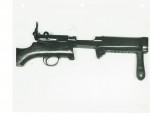
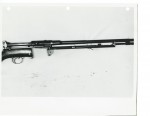











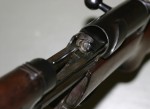
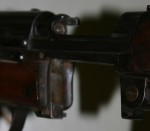

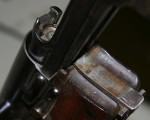
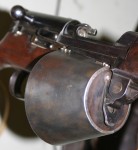
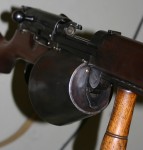





GREAT post ! Thanks!
I have,for a long time been fascinated by the spring-cocking system I would very interested in seeing drawings of either the
rifle or the machinegun based on the system,any suggestions?
Unfortunately, I don’t have a sketch of the system. However, I hope to do a disassembly video on one of them in the next few months. In the meantime, you might be able to find a patent drawing that shows some good detail.
Out of curiosity, how does the foregrip attach to the “rails”?
The bottom rail has a series of threaded holes down its length, and the front grip is topped with a threaded stud that will screw into whichever one you want to use.
I wasn’t expecting an answer so soon! Thanks very much for the quick reply.
From the photos I assume it uses a turning bolt.Can you
suggest an online source of patent drawings?[I am 83yrsold so I’d like to see drawings soon.
It occurs to me that since the operating system doesn’t
depend on the power of the cartridge you could use quick
-change barrels of different power as long as sufficient
gas was produced to cock the spring for instance 7.62nato,7.62#39,even,perhaps,7.62tokarev,or30″carbine,
what say you?
The gas system in theory should be relatively tolerant of caliber changes, although significant changes would require different springs, and possibly different sized gas ports. With the port towards the end of the barrel, there might not be enough pressure left to operate the system with a light cartridge like .30 Carbine.
Of course, this would also require changing the design to use a quick-change barrel. The existing guns use a threaded barrel not suitable for changing.
I found this patent by Farquhar and Hill, but it doesn’t reflect the final design of the production rifles:
http://www.google.com/patents/US867960
I believe this is the relevant patent:
https://www.google.com/patents/US1019620
867960 is the patent for the recoil-operated rifle,looks as though it was designed by a watchmaker.So,is there a US.paent for the gas-operated one?If not how can I access the British
patents?
so is it rotating bolt?
Yes.
You will find out a lot more about the Beardmore-Farquhar machine gun in a book called Beardmore Aviation ISBN-13 9780957344303 . The gun was based on an initial admiralty requirement for an automatic rifle. This rifle was adopted by the War Office for the spring campaign of 1919 but due to the Armistice it was cancelled. Beardmore turned it into an automatic machine gun and fitted three to the WBXXIV Latvian fighter. The gun was never manufactured by Beardmore but at the motor cycle firm of F.E.Baker. This made a loss of over £10000 for Beardmore. There was a rumour it had been fitted to RAF rescue vessels but this proved to be apocryphal.
Like the video. But Farquhar is pronounced “Farcher” with the ch being pronounced as in “loch”
Does anyone know whether there were any magazines for this gun other than 19-rounder? I heard about some other capacities, like 10-round box. Also, wikipedia states a 65-rounder, which i am unlikely to believe, since i am yet to find any evidence on such a tremendous mag.
What was the weight of this weapon?
What was the weight of this weapon?
It matters if you were to advance with it.